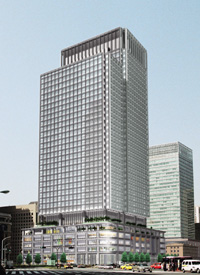Surviving the Chaos of Moving Your Office
Back to Contents of Issue: June 2005
|
|
|||||
|
by Dylan Robertson |
|||||
The Real Estate Advisor Senior management at major organizations realize that appointing a real estate professional to help them to devise and execute a real estate negotiation ensures that they are better prepared and informed than the landlord. Such an advisor, with experience in a variety of commercial real estate transactions, is able to execute rent review clauses that work in your company's favor. A sophisticated real estate advisor should offer more than the traditional real estate brokerage service of bringing together landlord and tenant. Creative problem solving and transaction structuring as well as sophisticated analytical capabilities are the strengths a real estate advisor should possess to identify and align real estate requirements with your strategic business, financial and operational objectives. Drawing on knowledge built on the experiences of their property professionals, they offer local market knowledge, industry-specific expertise and execution of the best possible real estate strategies for your business. A holistic view towards real estate is vital. Occupancy costs need to be viewed as part of your company's overall operational platform. Combining tenant representation services with project management services enables you to appoint a single full service real estate service provider, who is able to steer you through the acquisition process, from inception to completion. Your advisor should provide a range of services to assist you in optimizing your real estate portfolio and developing workplace solutions that maximize staff productivity and cost control. He or she should be able to offer an integrated approach to office relocation and manage the whole project, from the space planning and budgeting to the selection of interior designers, the coordination of the tendering process, and the management of vendor bids. Management of bids will ensure that the project arrives on time and on budget. Make sure you have a valid reason to move. Moving is a major decision, so it has to be for the right reason and preferably undertaken by a company in robust health. To think that relocation might be a cure for inefficiency, or mismanagement, is a common but faint hope. A move does not necessarily make problems go away -- so it is better to consider whether to stay put and try to address any major issues that you may have been using the relocation project to avoid. The Master Plan Top real estate consultants work with their clients to 'master plan' their current and future real estate needs. One important lesson learnt from our experience with various corporate occupiers is the need to build in flexibility. The increasingly competitive business environment has driven many companies to reassess their real estate cost base. Many firms have explored new 'workspace solutions' to provide teams with a more effective and efficient use of space, translating into significant cost savings. A master plan study helps major occupiers to achieve a clear audited process, due diligence of all feasible options, mutually agreed project scope and methodology, process-driven, informed decision making and early anticipation of occupancy strategies. Clients who are prepared to invest time in undertaking such thorough evaluations are able to reduce the costs involved in both one-off projects and ongoing internal churn, reduce project cycle time, improve business group adjacencies, identify new workplace solutions, create operational efficiencies, generate spatial savings and increase end-user satisfaction. You should carefully choose your new location for many reasons. If, for example, you are based in Tokyo, you will find that many of your staff commute from Kanagawa, Chiba, Saitama or west Tokyo. Many may have chosen their homes for the ease of the commute to the office - so a move across town may inconvenience them. Questions you should ask yourself:
An Opportunity to Make Changes Take the opportunity to make changes. Ask yourself some basic questions. Are you getting the best available service from all your existing providers? Will they even be available after you relocate? Moving is an opportunity for them to improve their service to you -- or for you to chance a change in providers. It is an ideal time for renegotiating services, changing suppliers and bringing a broom to areas of the company not normally scrutinized. An office relocation is often an ideal opportunity to reconfigure your workplace in order to get a higher return on investment in your office space by maximizing the synergy, efficiency and productivity of your workers. Do your sales staffs need large desks if they are out of the office most of the time? What departments should be adjacent to each other? What are your meeting room usage patterns? How can you reduce the space used for hard-copy document storage? All this means further work though, and at the time you least need it; so make
as much advanced preparation as possible. The rewards can include freeing up
resources, improving efficiency and profits and reinvigorating the company.
Don't wait until you are bursting at the seams and sitting on top of each other
to start the process. Ideally, you should start preparing for your office relocation
at least twelve months before you want to be sitting in the new space.  SHIN-MARUNOUCHI
BUILDING SHIN-MARUNOUCHI
BUILDING Mitsubishi Estate owns and manages 30 buildings in the Marunouchi area, centered on Tokyo Station, and has been striving to create an environment that will attract major office tenants. As the buildings reach the end of their life-cycles, they are being sequentially torn down and rebuilt. The newest addition will be the 38-story Shin-Marunouchi Building, scheduled for completion in 2007. Like all the new projects in the Marunouchi area in central Tokyo, the Shin-Marunouchi Building should be a success. Even before construction began, the building, to be situated in front of Tokyo Station, the hub of the Bullet Train network, had pricked blue-chip companies' interest. The Marunouchi Building (2002) portends success for what will be its non-identical twin across the street -- non-identical because the Marunouchi Building balances traditional influences and modern design, whereas the new building will be much more modern. The Marunouchi Building is connected by an underground corridor to Tokyo Station. Thus not only metro area commuters but also rail passengers from around Japan patronize the several floors of retail in basement levels and the upper-story restaurants, packed every day of the week. The station connection should also channel patrons to the Shin-Marunouchi Building. The Marunouchi Building has been fully occupied with excellent organizations well known internationally, and the Shin-Marunouchi Building, which will be built to even higher specifications, will attract a similar caliber of tenant. Flanking the road running along the west side of Tokyo Station toward the Imperial Palace, the two buildings will resemble giant gateposts or koma-inu, the guardian dogs at the entrance to a Japanese shrine. -D.R. *****
|
|||||
Note: The function "email this page" is currently not supported for this page.






